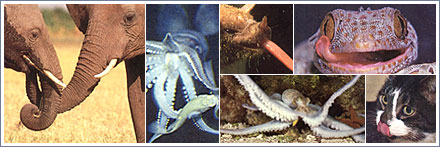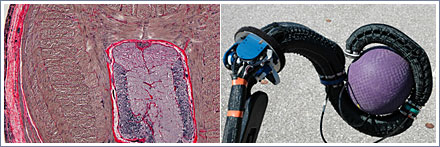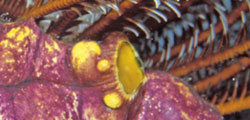Research
Hydrostatic Skeletons and Muscular Hydrostats
I am interested in a fascinating group of muscular animal structures (examples include the arms and tentacles of cephalopods, the tongues of mammals and lizards, and the trunk of the elephant) that consist of a densely packed three-dimensional array of muscle fibers. These structures lack the rigid elements that characterize the skeletal support systems in many animals such as arthropods (insects, spiders, and crabs) and vertebrates. They also lack the fluid-filled cavities that provide a type of skeletal support termed a “hydrostatic skeleton” that is common in many invertebrate animals. Analysis of the morphology and biomechanics of these structures has revealed that the musculature not only generates the forces required for movement, deformation and changes in stiffness, it also provides the required skeletal support. We call these remarkable organs “muscular hydrostats” because the musculature itself provides skeletal support in a manner related to that of animals with more conventional hydrostatic skeletons.

Examples of muscular-hydrostats
Muscular hydrostats exhibit a remarkable diversity and complexity of movement. Unlike structures with rigid skeletal elements whose movements are restricted to joints, deformations such as bending, elongation, shortening, and twisting can occur at any location and at multiple locations simultaneously along the length of the organ. In addition, compared with conventional hydrostatic skeletons the deformations can be highly localized. The amazing range of movement, adaptability, and compliance of an octopus arm or of a tongue during feeding or vocalization is made possible by this type of dynamic skeletal support system.

Transverse histological section of octopus arm showing dense musculature (left)
Robotic arm can manipulate flexible objects such as this ball by wrapping (right)
I was involved previously in a fascinating collaboration with a group of engineers and biologists to develop robotic arms inspired by muscular hydrostats such as the arms and tentacles of octopus and squid, and the elephant trunk. These “hyper redundant” robotic arms have numerous advantages over conventional robotic arms, in particular in manipulating and handling objects that vary in mass, size, surface texture, and mechanical properties in complex and unstructured environments.
Selected Resources:
Structure and Function of Muscular-Hydrostats:
Overview and General Principles
Kier, W.M. and Smith, K.K. (1985) Tongues, tentacles and trunks: The biomechanics of movement in muscular-hydrostats. Zoological Journal of the Linnean Society 83: 307-324.
Smith, K.K. and Kier, W.M. (1989) Trunks, tongues, and tentacles: Moving with skeletons of muscle. American Scientist 77: 28-35.
Muscular Hydrostats in Cephalopods
Kier, W.M. (1982) The functional morphology of the musculature of squid (Loliginidae) arms and tentacles. Journal of Morphology 172: 179-192.
Kier, W.M. (1987) The functional morphology of the tentacle musculature of Nautilus pompilius. In Nautilus: Biology and Paleobiology of the Living Fossil, Saunders, W.B. and Landman, N.H. (Eds.). pp. 257-269. New York: Plenum.
Kier, W.M. (1989) The fin musculature of cuttlefish and squid (Mollusca, Cephalopoda): Morphology and mechanics. Journal of Zoology (London) 217: 23-38.
Kier, W.M., Smith, K.K., and Miyan, J.A. (1989) Electromyography of the fin musculature of the cuttlefish, Sepia officinalis. Journal of Experimental Biology 143: 17-31.
Kier, W.M. and Smith, A.M. (1990) The morphology and mechanics of octopus suckers. Biological Bulletin 178: 126-136.
Johnsen, S. and Kier, W.M. (1993) Intramuscular crossed connective tissue fibres: skeletal support in the lateral fins of squid and cuttlefish. Journal of Zoology. 231: 311-338.
Thompson, J.T. and Kier, W.M. (2001) Ontogenetic changes in mantle kinematics during escape jet locomotion in the Oval Squid, Sepioteuthis lessoniana Lesson, 1830. Biological Bulletin 201: 154-166.
Thompson, J.T. and Kier, W.M. (2001) Ontogenetic changes in fibrous connective tissue organization in the Oval Squid, Sepioteuthis lessoniana Lesson, 1830. Biological Bulletin 201: 136-153.
Kier, W.M. and Smith, A.M. (2002) The structure and adhesive mechanism of octopus suckers. Integrative and Comparative Biology. 42: 1146-1153.
Kier, W.M. and Thompson, J.T. (2003) Muscle arrangement, function and specialization in recent coleoids. Berliner Paläobiologische Abhandlungen 03: 141-162.
Uyeno, T. A. and Kier, W. M. (2005) Functional morphology of the cephalopod buccal mass: a novel joint type. Journal of Morphology. 264: 211-222.
Uyeno, T.A. and Kier, W.M. (2007) Electromyography of the buccal musculature of octopus (Octopus bimaculoides): a test of the function of the muscle articulation in support and movement. Journal of Experimental Biology. 210: 118-128.
Kier, W.M. and Stella, M.P. (2007) The arrangement and function of octopus arm musculature and connective tissue. Journal of Morphology. 268: 831-843.
Kurth, J.A., Thompson, J.T. and Kier, W.M. (2014) Connective tissue in squid mantle is arranged to accommodate strain gradients. Biological Bulletin. 227: 1-6.
Kier, W. M. (2016) The musculature of coleoid cephalopod arms and tentacles. Frontiers in Cell and Developmental Biology. 4:10.
Taylor-Burt, K.R., Kier, W.M., Olszewski-Jubelirer, J. and Thompson, J.T. (2018) Shape, size and structure affect obliquely striated muscle function in squid. Integrative and Comparative Biology. 58: 261-275.
Other Muscular Hydrostats:
Kier, W.M. (1988) The arrangement and function of molluscan muscle. In The Mollusca, Form and Function, Trueman, E.R. and Clarke, M.R. (Eds.), Wilbur, K.M. (Ed.-in-Chief). 11: 211-252. New York: Academic Press.
Kier, W.M. (1992) Hydrostatic skeletons and muscular hydrostats. In: Biomechanics (Structures and Systems): A Practical Approach. Biewener, A.A. (Ed.), IRL Press at Oxford University Press.
Thompson, J.T., Lowe, A.D. and Kier, W.M. (1998) The columellar muscle of prosobranch gastropods: morphological zonation and its functional implications. Invertebrate Biology. 117: 45-56.
Uyeno, T.A. and Kier, W.M. (2010) Morphology of the muscle articulation joint between the hooks of a flatworm (Kalyptorhynchia, Cheliplana sp.) Biological Bulletin. 218: 169-180.
Uyeno, T.A. and Kier, W.M. (2015) The structure and function of a muscle articulation-type jaw joint of a polychaete worm. Journal of Morphology. 276: 403-414.
Hydrostatic Skeletons:
McCurley, R.S. and Kier, W.M. (1995) The functional morphology of starfish tube feet: the role of a crossed-fiber helical array in movement. Biological Bulletin. 188: 197-209.
Taylor, J.R.A. and Kier, W.M. (2003) Switching skeletons: hydrostatic support in molting crabs. Science. 301: 209-210.
Taylor, J.R.A. and Kier, W.M. (2006) A pneumo-hydrostatic skeleton in land crabs. Nature. 440: 1005.
Taylor, J.R.A., Hebrank, J. and Kier, W.M. (2007) Mechanical properties of the rigid and hydrostatic skeletons of molting blue crabs, Callinectes sapidus Ratthbun. Journal of Experimental Biology. 210: 4272-4278.
Salisbury, S.M., Martin, G.C., Kier, W.M., and Schulz, J.R. (2010) Venom kinematics during prey capture in Conus: the biomechanics of a rapid injection system. Journal of Experimental Biology. 213: 673-682.
Kier, W.M. (2012) The diversity of hydrostatic skeletons. Journal of Experimental Biology. 215: 1247-1257.
Kurth, J.A. and Kier, W.M. (2014) Scaling of the hydrostatic skeleton of the earthworm, Lumbricus terrestris. Journal of Experimental Biology. 217: 1860-1867.
Kurth, J.A., and Kier, W.M. (2015) Differences in scaling and morphology between lumbricid earthworm ecotypes. Journal of Experimental Biology. 218: 2970-2978.
Robotics Inspired by Muscular Hydrostats
Walker, I.D., Dawson, D.M., Flash, T., Grasso, F.W., Hanlon, R.T., Hochner, B., Kier, W.M., Pagano, C.C., Rahn, C.D. and Zhang, Q.M. (2005) Continuum Robot Arms Inspired by Cephalopods. Proceedings of SPIE. 5804: 303-314.
Trivedi, D., Rahn, C.D., Kier, W.M. and Walker, I. D. (2008) Soft robotics: Biological inspiration, state of the art, and future research. Applied Bionics and Biomechanics. 5: 99-117.
Sholl, N., Moss, A., Kier, W.M., and Mohseni, K. (2019) A soft end effector inspired by cephalopod suckers and augmented by a dielectric elastomer actuator. Soft Robotics. https://doi.org/10.1089/soro.2018.0059
Tekinalp, A., Naughton, N., Kim, S-H., Halder, U., Gillette, R., Mehta, P.G., Kier, W.M. and Gazzola, M. (2024) Topology, dynamics, and control of a muscle-architected soft arm. Proceedings of the National Academy of Sciences. 121, No. 41, e2318769121. https://doi.org/10.1073/pnas.2318769121.
Structure and Function of Tongues
Nishikawa, K., Smith, K.K. and Kier, W.M. (1999) Morphology and mechanics of tongue movement in the African pig-nosed frog Hemisus marmoratum: a muscular hydrostatic model. The Journal of Experimental Biology 202: 771-780.
Van Leeuwen, J.L., de Groot, J.H., and Kier, W.M. (2000) Evolutionary mechanics of protrusible tentacles and tongues. Netherlands Journal of Zoology. 50: 113-139.

